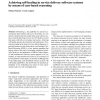CG
2007
Springer
14 years 18 days ago
2007
Springer
In this article we describe an ongoing effort to integrate information visualization techniques into the process of configuration management for software systems. Our focus is to...
APIN
2008
14 years 21 days ago
2008
Abstract Self-healing, i.e. the capability of a system to autonomously detect failures and recover from them, is a very attractive property that may enable large-scale software sys...
AAMAS
2010
Springer
14 years 22 days ago
2010
Springer
Holonic multiagent systems (HMAS) offers a promising software engineering approach for developing complex open software systems. However the process of building MultiAgent Systems...
DAGSTUHL
2009
14 years 1 months ago
2009
It is commonly agreed that a self-adaptive software system is one that can modify itself at run-time due to changes in the system, its requirements, or the environment in which it ...
DAGSTUHL
2009
14 years 1 months ago
2009
To deal with the increasing complexity of software systems and uncertainty of their environments, software engineers have turned to self-adaptivity. Self-adaptive systems are capab...
APCCM
2009
14 years 1 months ago
2009
Application domain description precedes requirements engineering, and is the basis for the development of a software or information system that satisfies all expectations of its u...
IWFM
1998
14 years 1 months ago
1998
Models of software systems are built in Z and VDM using partial functions between sets and certain operations on these partial functions : extension ( ), restriction ( ), removal ...
SERP
2003
14 years 1 months ago
2003
In recent publications, two prominent approaches can be found which deal with the complexity of large software systems. First, there is the object–oriented approach, where ”ob...
WOA
2001
14 years 1 months ago
2001
In this paper, we identify and analyze a set of issues that are more and more influencing the characteristics of today's complex software systems, and that distinguish them f...
CATA
2003
14 years 2 months ago
2003
In this paper we present a new method of combining multiple precedence constraints for a single task to support software systems having client-server relationships. In these types...




